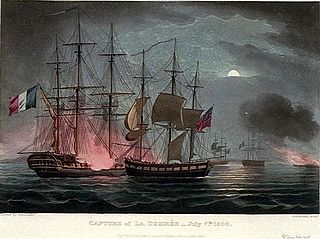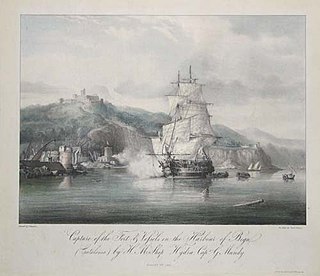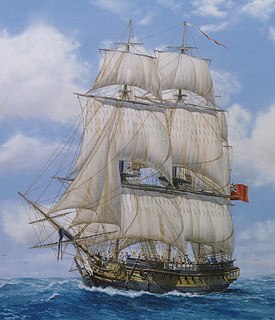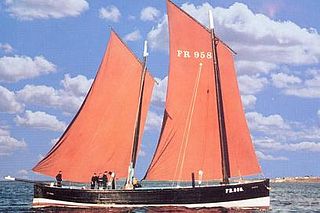The first lugger Nile
The first lugger Nile had a burthen of 17618⁄94, and was armed with two 6-pounder guns and ten 12-pounder carronades. She served on a contract from 23 March 1799 to 21 November 1801.
Builder's Old Measurement is the method used in England from approximately 1650 to 1849 for calculating the cargo capacity of a ship. It is a volumetric measurement of cubic capacity. It estimated the tonnage of a ship based on length and maximum beam. It is expressed in "tons burden", and abbreviated "tons bm".

A carronade is a short, smoothbore, cast-iron cannon which was used by the Royal Navy and first produced by the Carron Company, an ironworks in Falkirk, Scotland. It was used from the 1770s to the 1850s. Its main function was to serve as a powerful, short-range, anti-ship and anti-crew weapon. Carronades were initially found to be very successful, but they eventually disappeared as naval artillery advanced, with the introduction of rifling and consequent change in the shape of the projectile, exploding shells replacing solid shot, and naval engagements being fought at longer ranges.
From 1799 to 1800 Nile was under the command of Lieutenant Ricard Whitehead. On 12 January 1800 Nile was under the command of her master, Stephen Butcher (or Bucher), Lieutenant Whitehead being ill on shore, when she captured the French privateer lugger Moderé. Modere was armed with four 4-pounder guns and had a crew of 42 men. She was only six hours out of Boulogne and hand not taken anything. As Nile was boarding her prize, Nemesis came up. Captain Baker, of Nemesis took Moderé in charge and took her, as well as another captured privateer, Renard, and a recaptured brig, and took them into the Downs. Before leaving, Baker sent Nile to watch the port of Calais to try and intercept some other privateer luggers known to be out, and any captured British ships. [2] Nile shared in the proceeds of Moderé and Renard with Nemesis and the cutter Stag. [3]
HMS Nemesis was a 28-gun Enterprise-class sixth-rate frigate of the Royal Navy. The French captured her in 1795 at Smyrna, but in 1796 a squadron led by Barfleur brought her out of the neutral port of Tunis. Throughout her career she served under a number of commanders who would go on to have distinguished careers. She was converted to a troopship in 1812 and was sold in 1814.
On 6 February Nile brought into Deal two recaptured West Indiamen, one, Elizabeth, had sailed from Jamaica. [4]
At some point in early 1800, Nile and the hired armed cutter Earl Spencer recaptured Molly, which was in ballast. [5] This was probably Molley, which had been sailing from Exeter to Newcastle when a French privateer had captured her. Molley came into Deal on 14 February. [6]
Nile was among the many British vessels that shared in the proceeds of the capture of the French frigate Désirée, which HMS Dart, under Patrick Campbell, captured on 8 July in the Raid on Dunkirk. Nile, under Butcher, performed a useful service by laying as a leading mark at Gravelines Hook. [7] [8] Nile then brought the news of the action into Dover the next day. [9]

Désirée was a Romaine-class frigate of the French Navy. The British Royal Navy captured her in 1800 and took her into service under her existing name. she was laid up in 1815, converted to a slop ship in 1823, and sold in 1832.
Nine ships of the Royal Navy have borne the name HMS Dart, after the River Dart in Devon:
Vice-Admiral Sir Patrick Campbell, KCB was a senior British Royal Navy officer of the early nineteenth century who was distinguished by his service in the French Revolutionary and Napoleonic Wars. During his service in a number of ships in the Mediterranean and English Channel, Campbell saw several small ship actions and was successful in every one, even surviving a double shipwreck in 1805. Following the war, Campbell retired for ten years before returning to service, later commanding at the Cape of Good Hope.
While under Bucher's command, Nile captured Marie. [10]
On 25 July 1800 Nemesis was part of a squadron that also included Terpsichore, Prevoyante, Arrow, and Nile, when it encountered the Danish frigate HDMS Freja, which was escorting a convoy of two ships, two brigs and two galliots. [11] Baker hailed her and said that he would send a boat to board the convoy. The Danish captain refused, and said that if a boat approached he would fire on it. Baker sent a midshipman and four men in a boat, and the Danes fired several shots, which missed the boat, but one of which killed a man on Nemesis. Nemesis then opened fire with her broadside. After an engagement of about 25 minutes, Freja, much damaged, struck. She had suffered eight men killed and many wounded; both Nemesis and Arrow each suffered two men killed and several wounded. [12] The British brought Freya and her convoy into the Downs on 6 March. [11] They later released her, and presumably the rest of the convoy. This incident led to strained relations with Denmark, and, in order to anticipate any hostile move from Copenhagen, the British government despatched Earl Whitworth in August on a special mission to Copenhagen. The Danes not being ready for war, his mission staved off hostilities for about a year. In 1807, after the second battle of Copenhagen, the British captured Freja and took her into the Royal Navy as HMS Freya.
Much less momentously, on 27 October, Nemesis and Nile captured five fishing vessels. [13]
On 1 November Nile captured the French privateer Renard off Folkestone. Lieutenant Whitehead was again sick on shore so Nile was under the command of Mr. Butcher. Renard was armed with two 3-pounder guns, and had a crew of 13 men under the command of Michael Bernard Hamelin. She had left Calais at 4pm the previous afternoon and when she was captured she was alongside a merchant ship. [14]
Second lugger Nile
The second lugger Nile had a burthen of 17022⁄94, was armed with fourteen 12-pounder carronades, and had a crew of 50 men. She served on a contract from 26 April March 1804 to 25 October 1806. The Admiralty paid an annual charge of £4576 for her hire. [16] She may have been the lugger Nile of 174 tons, fourteen 12-pounder guns, and 55 men under the command of John Blake, that received a letter of marque on 21 July 1803. [17]
In 1805 Nile was under the command of Lieutenant John (or George) Fennell (or Fennel). In March she captured the French chasse maree Deux Freres and the brig St François. [18] On 17 June Nile captured the French brig Jeune Nanine. [19]
Fennel was still in command of Nile at the battle of Cape Finisterre (Calder's Action). Though the cutter Frisk and Nile stayed out of the fight and suffered no casualties, [20] as per regulations they shared in the proceeds for the capture of the Spanish ships Firme and San Rafael. [21]
Fennel died in 1805 and his replacement, in September, was Lieutenant Symonds (or Simmonds). [22] [23] On 2 May 1806 Nile was in company with two Jersey privateers, the Success and the Phoenix, when they captured the Spanish brig Santa Alodias, or Alvalia. [24] [Note 1]
Nile may also have been the lugger Nile, of 175 tons (bm), ten 12-pounder guns, and 40 men, whose master, Thomas Butcher, received a letter of marque on 30 December 1808. [17]

HMS Indefatigable was one of the Ardent class 64-gun third-rate ships-of-the-line designed by Sir Thomas Slade in 1761 for the Royal Navy. She was built as a ship-of-the-line, but most of her active service took place after her conversion to a 44-gun razee frigate. She had a long career under several distinguished commanders, serving throughout the French Revolutionary Wars and the Napoleonic Wars. She took some 27 prizes, alone or in company, and the Admiralty authorised the issue of four clasps to the Naval General Service Medal in 1847 to any surviving members of her crews from the respective actions. She was broken up in 1816.

HMS Hydra launched in 1797 was a fifth-rate frigate of the Royal Navy, armed with a main battery of twenty-eight 18-pounder guns.

HMS Melampus was a Royal Navy fifth-rate frigate that served during the French Revolutionary and Napoleonic Wars. She captured numerous prizes before the British sold her to the Royal Netherlands Navy in 1815. With the Dutch, she participated in a major action at Algiers and, then, in a number of colonial punitive expeditions in the Dutch East Indies.
HMS Wolverine was a Royal Navy 18-gun Cruizer-class brig-sloop, launched in 1805 at Topsham, near Exeter. Early in her career she was involved in two fratricidal incidents, one involving a British frigate and then a newsworthy case in which she helped capture a British slave ship. She later captured a small naval vessel and several privateers, and took part in the invasion of Martinique, and during the War of 1812, in the attack on Baltimore. Wolverine was decommissioned in August or September 1815 and was sold on 15 February 1816.
HMS Atalante was a 16-gun brig-sloop of the Royal Navy. She was formerly the French Atalante, captured in 1797. She served with the British during the French Revolutionary and Napoleonic Wars, and was wrecked in 1807.
His Majesty's hired armed cutter Courier appears twice in the records of the British Royal Navy. The size and armament suggests that both contracts could represent the same vessel, but other information indicates that the second Courier had been captured from the French in the West Indies. On the first contract the captain and crew were awarded clasps to the Naval General Service Medal, one for a boat action and one for a single ship action in which they distinguished themselves.
During the French Revolutionary and Napoleonic Wars, British vessels captured at least 12 French warships and privateers named Espoir, which means “Hope” in French. In only one case was there mention of an exchange of fire or casualties. In general, the privateers tried to escape, and failing that surrendered.
Eleven ships of the French Navy have borne the name Renard, after the Fox or the character Reynard. The name was also popular for privateers.
The French lugger Affronteur was launched in 1795 and in 1796-7 participated in the Expédition d'Irlande. In 1803, HMS Doris captured her and she subsequently served the Royal Navy either as a commissioned vessel or, more probably, as His Majesty's hired armed brig Caroline. In 1807 she was either broken up, or became a letter of marque.
During the French Revolutionary and Napoleonic WarsThe British Royal Navy employed at least two cutters designated His Majesty's hired armedcutterNile.
His Majesty's hired armed vessel Aristocrat served the Royal Navy, twice, as a lugger from 1794 to 1798, and as a brig from 1799 to 1801. She served with the Jersey-based Channel Islands flotilla under Commodore Philippe d'Auvergne, Prince of Bouillon. As a lugger she participated in two notable engagements, the second of which won for her crew the Naval General Service Medal, awarded some 50 years later. As a brig, she captured two privateers.
Two vessels have borne the designation, His Majesty's hired armed cutter Lion. The first served during the French Revolutionary Wars, capturing five privateers and several merchant vessels. The second served briefly at the start of the Napoleonic Wars. Both vessels operated in the Channel. The two cutters may have been the same vessel; at this juncture it is impossible to know. French records report that the French captured the second Lion in 1808 and that she served in the French Navy until 1809.
HMS Renard was the French privateer Renard, launched in 1797, that Cerberus captured in the Channel that same year. The Royal Navy took her into service under her existing name and she participated in some notable engagements on the Jamaica station before the Navy sold her in 1809.
HMS Milbrook was one of six vessels built to an experimental design by Sir Samuel Bentham. After the Royal Navy took her into service in her decade-long career she took part in one notable single-ship action and captured several privateers and other vessels, all off the coast of Spain and Portugal. She was wrecked on the Portuguese coast in 1808.
His Majesty's Hired armed cutter George was a cutter that served the Royal Navy between 6 June 1798 and 12 November 1801 under contract. She had a burthen of 125 34⁄94 tons (bm), and was armed two 6-pounder guns and twelve 12-pounder carronades. She captured one French privateer. During the Napoleonic Wars the French captured her and she served the French Navy until September 1813; she was struck from the French Navy's lists ca. 1816.
His Majesty's hired armed schooner Lady Charlotte served the British Royal Navy on contract between 28 October 1799 and 28 October 1801. She had a burthen of 120 85⁄94 tons (bm), and was armed with twelve 12-pounder carronades. As a hired armed vessel she captured several privateers and recaptured a number of British merchant vessels. After her service with the Royal Navy, she apparently sailed as a letter of marque until the French captured her in 1806.
Sorcière was the name of several privateers that sailed during the Napoleonic Wars. Three were French vessels, but one was British, though the British Sorciere was probably the Sorcière launched in 1803 at Saint-Malo that the British Royal Navy captured in April 1806.
Numerous French privateers have borne the name Vengeur ("Avenger"):
HMS Experiment was launched in 1793, the only lugger actually designed and built for the British Royal Navy. The Spanish Navy captured her in 1796 near Gibraltar. A British privateer recaptured her in 1806, but the Royal Navy did not take her back into service.







